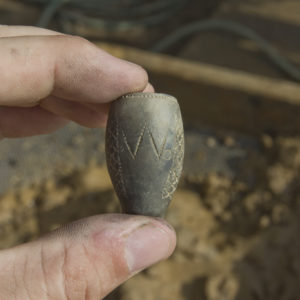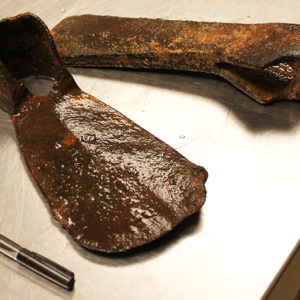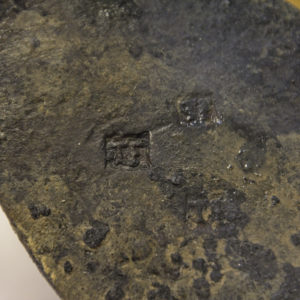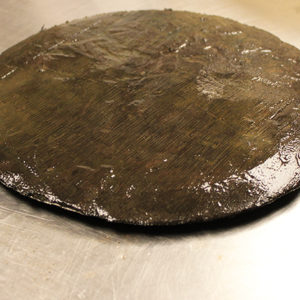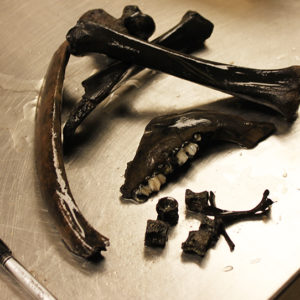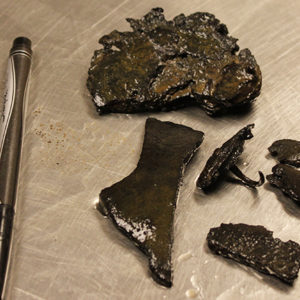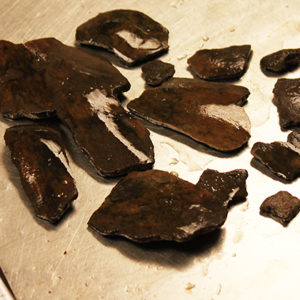Excavations have concluded on a mid-17th-century well located in the southwest corner of James Fort’s 1608 church. Several artifacts were found in the bottom of the well including a hoe blade stamped with a maker’s mark, a pewter spoon also bearing a maker’s mark, an axe head, a decorated pipe bowl, fragments of a leather shoe, and dozens of animal bones. These artifacts are in remarkable condition due to the fact that they’ve remained submerged below the water table for over 300 years. Though the well is located just inside the southwest corner of the church, its position is merely coincidental, as the church had been torn down decades before the construction of the well.
The wells at Jamestown have yielded a remarkable array of artifacts, in large part due to the fact that they were used as trash dumps once they ceased to be used as a water source. The excavations of this well have turned up substantially fewer artifacts than those of previous wells. This may indicate a well that was in private rather than public use. Its small diameter and its mid-17th-century construction date may give credence to this theory. By this time, James Fort had expanded to become Jamestown, and its land was largely held in private hands. If this well was indeed a private one, there were probably less people using it while it was a water source and less people using it as a trash dump once the water turned sour (which probably didn’t take too long given its proximity to the brackish James River). That being said, while there were less artifacts found overall, there were still a substantial number of artifacts found at all levels of the well excavation. Finds discovered above the water table include human teeth, beads, pipe fragments, and a portion of a crucible.
The latest finds, discovered underwater, include a hoe blade, an axe head, pieces of a leather shoe, gourd fragments, and a pewter spoon. These artifacts are in wonderful shape, due to the fact that they lay under water since they were dropped in the well some 350 years ago. Because they were not exposed to the air above, the iron objects are largely rust-free, and organic artifacts such as the leather shoe fragments appear much as they did when they were dropped into the well. The hoe blade has four of the same maker’s mark, the letters “TF” imprinted on it. It is not known who “TF” was; he may very well have been an English blacksmith.
A pewter spoon, found beneath the water table as well, also bears a maker’s mark, but it is only partially visible due to wear. A pipe bowl was found in the bottom of the well. It is rouletted with a star and the initial “W” and is believed to have been made by a pipemaker working in the Charles City County, Virginia area between c. 1635-60. Organic materials found in the bottom of the well include leather shoe fragments, mammal bones, fish vertebrae, pieces of a gourd, and the wooden bottom of a well bucket.
The Jamestown Rediscovery archaeological team is starting to wrap up this year’s excavations in preparation for colder weather and will spend the winter writing reports detailing 2011’s findings. A new exhibit is currently being installed in the Voorhees Archaearium, Historic Jamestowne’s archaeological museum. The exhibit will focus on the artifacts found in and around Fort Pocahontas’ bombproof. Fort Pocahontas was built in 1861 by enslaved workers to defend the James River from Union gunboats headed upriver. This year, the Jamestown Rediscovery archaeologists excavated Fort Pocahontas’ bombproof, and the some of the artifacts found during the excavations will be on display in the new exhibit. In addition to the latest finds, selected Civil War-era artifacts found on the island through the years will also be part of the exhibit. An iron vambrace, a piece of armor that protects the elbow and surrounding portions of the arm, is one of the highlights of the exhibit. This James Fort-period artifact was found by the enslaved workers who were excavating earth to construct Fort Pocahontas’ earthworks and it is on loan from the Virginia Historical Society.
related images
- The newly-discovered tobacco pipe found in the well
- Another view of the recently-found pipe bowl
- The maker’s mark on the pewter spoon
- The hoe blade and axe head
- One of the maker’s marks on the hoe
- The bottom of a bucket
- Some of the animal bones found in the well
- Shoe fragments found in the well
- Gourd fragments found in the well




